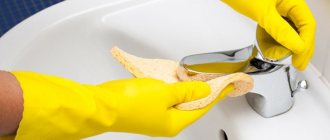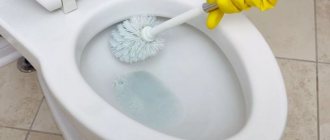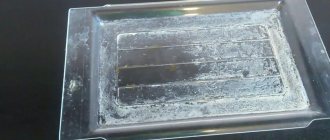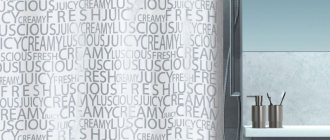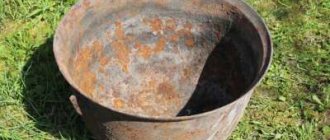Cleansing techniques
Connoisseurs are familiar with a number of methods on how to easily lighten a toilet using publicly available resources that are easy to find in every home:
- A glass of 9% vinegar heated to 40 degrees, poured into a tank for a couple of hours, can clean off a significant part of the dirt. To enhance the result, it is recommended to add a few drops of iodine or a little salt. Carry out the procedure in the evening so that the liquid remains in the item being cleaned all night. To enhance the effect, repeat the procedure a number of times.
- A suitable alternative to vinegar is citric acid. For one cleaning, just pour in and leave the contents of 2 sachets for a couple of hours. Experts say that ordinary citric acid overcomes limescale blockages faster. In order to get a toilet of pristine cleanliness, it is enough to repeat the procedure 2-3 times.
- Multifunctional, absolutely familiar “Whiteness” is poured into the unit, which has been previously freed from water using a valve or cup. It is not recommended to fill the toilet tank with white, because it quickly separates chlorine and negatively affects the body.
- One of the most common toilet cleaners is baking soda. It is poured over the entire dirty surface and left overnight. Soda is good because it does not produce toxic fumes when interacting with lime. Even a child should not be afraid to go to the bathroom in the morning.
Removing stains with citric acid
Citric acid is great for removing scale from your washing machine and kettle. Dissolved, it perfectly cleans plaque formations.
To obtain a solution of the desired composition and consistency, you should:
- Take half a liter of running water and heat it to a warm temperature.
- Add 60 grams of citric acid, mix carefully and thoroughly (since residual fine grains can harm the surface).
The resulting liquid must be placed on the area with plaque. After 15 minutes, rinse with a napkin.
To remove complex limescale stains, place a sponge moistened in an acid mixture on top of them for 30–40 minutes. Repeating this operation is possible until the contamination is completely removed.
How can you clean a toilet from limescale?
Various minerals and lime present in the water linger on the surface of the toilet in the form of a characteristic coating. The hardness of the water determines the speed of its occurrence - the higher it is, the faster the layering occurs. The process can take from several weeks to months. Removing a thin layer of lime is possible with conventional toilet cleaning products, which are applied to its entire internal surface and left overnight, after which the deposits are cleaned off with a brush and washed off with water.
There are many special products that can dissolve layering - Domestos, Toilet duckling, Santry and others. Their cost varies from quite cheap to very expensive. With their help, plaque can be dissolved very quickly without labor-intensive processes. Therefore, if you are not allergic to these products, then they can be used in cases of severe plaque that does not respond to folk remedies. To use factory products:
- read the instructions carefully;
- put on rubber gloves;
- remove all liquid from the toilet drain, dry the surface with a rag;
- apply the product;
- leave it for the time specified in the instructions;
- clean the plaque with a brush;
- close the toilet lid and flush the product.
Toilet duck and other industrial products are good at removing plaque and unpleasant odors from the surface of the toilet bowl
If you want the toilet to retain its original appearance for a long time, take preventative measures. They will help prevent plaque from occurring. And if it appears, first try some proven folk remedies, including:
- baking soda;
- vinegar;
- lemon acid;
- Coca Cola;
- Whiteness, etc.
Where does plaque come from?
I would like to note right away that it is almost impossible to prevent the appearance of plaque, since the main reason for its appearance is the evaporation of water, which interacts with soap.
True, tap water even by itself leaves a residue, since it contains a large amount of mechanical particles and salts. After the water dries, all these minerals and other elements are deposited on the surface in the form of a gray coating. If the water is rich in iron, it can also color the surface a characteristic orange color. As a result, a snow-white bathroom in a very short time turns into an unsightly container of a “gray-brown-raspberry” color.
Limescale may appear on faucets and other surfaces
Of course, after each use you can wipe the bathtub with a dry cloth. In this case, you will not see the plaque soon. However, it is impossible to keep track of all the drops that fall on the surface, so sooner or later you will still have to face the need to remove deposits.
Currently, there are many household chemicals on sale that effectively clean both types of plaque. However, most formulations are based on acids, as a result of which they are very toxic and can even cause burns if they come into contact with the skin. Powder products are more environmentally friendly, however, they scratch the surface of the plumbing fixtures, as a result of which it gradually loses its original attractive appearance.
Therefore, all kinds of “folk” remedies are very relevant in our time.
We are taking tough measures
Complex stains are removed using concentrated acids. When working with chemicals at home, use rubber gloves, a protective gown or plastic apron, and a respirator. Do not close the doors to the toilet, and after treatment, thoroughly rinse the toilet and thoroughly ventilate the room as a whole.
Dry oxalic acid. Technical acid is sold in powder form. It is applied to a piece of cloth and the dirt is rubbed off manually.
When washing the toilet this way, you need to take precautions. Electrolyte for acid batteries. This substance allows you to get rid of difficult-to-remove plaque
Contains concentrated acid. Cannot be used if sewer pipes are made of plastic. Pour it into the toilet, and after half an hour or an hour, wash it off with water. Hydrochloric acid. Sold in plumbing stores, usually used for cleaning water heaters in gas boilers, water heaters, etc. The principle is the same as with electrolyte. With its help you can get rid of all types of stone. Iodine monochloride. Liquid product, you can buy it in veterinary pharmacies. Perfectly removes all types of stone. The solution is poured over the contaminated areas and almost immediately washed off with water - the product eats away lime deposits and rust within a few minutes. Cannot be used in homes where sewer pipes are made of cast iron. Iodine monochloride is also aggressive to aluminum.
And finally, we note that it is undesirable to use potent products too often - they spoil the surface of the plumbing fixtures, leaving microdamages on it. After washing off the limescale and stone once, sanitize the toilet regularly. If you have bad water, install house filters or use special tablets to prevent the formation of plaque in the tank and toilet.
It's better not to clean the bathtub
Chrome faucets should not be cleaned with abrasive powders or strong acids.
When working, do not use steel sponges, hard brushes, or scrapers. They leave scratches on any material.
Enameled items cannot be treated with inorganic acids.
Powders are not used for chrome-plated faucets.
Products from the kitchen
Every kitchen has universal means for washing dishes, removing clogs and dirt from all surfaces:
- vinegar;
- soda;
- lemon acid;
- white.
They are used to remove limescale from the toilet and clean it until it shines.
It is preferable to get 70% vinegar, vinegar essence. It is poured into the toilet, approximately 200 - 250 ml and 100 ml into the tank, covered with a lid and left for 15 - 20 minutes. After this, rub all surfaces well with a brush or steel wool and rinse. When the tank is full, it is advisable to rinse it again.
To use 9% vinegar, before removing limescale, you need to remove water from the siphon, otherwise the concentration of the acid solution will be weak and will not cope with limescale, especially urinary stones. Water can be removed by pushing it with a plunger, scooping it out with a glass, or soaking it with a rag.
A 500 ml bottle of vinegar is poured into the toilet, into the low tide, which is the hardest to clean and collects the thickest layer of dirt. Then paper napkins are moistened and placed under the rim; you can cover the entire surface of the bidet with them. Cover with a lid for about an hour. Then clean everything well with a brush, rub hard-to-reach places in the knee with a washcloth or toothbrush. Remove the napkins. Rinse everything off with water and ventilate the toilet to remove the smell of vinegar.
How to remove plaque with a large layer of urinary stone. Add 50 drops of iodine and a tablespoon of soda to vinegar heated to 45 - 50 degrees. Pour into a toilet bowl that has been emptied of water and close the lid for 2 to 3 hours. Then wipe off the red coating and rinse it off the tank with water.
How to remove plaque if you don’t have vinegar on hand. It is enough to sprinkle a pack of citric acid evenly at night. In the morning, clean and rinse. The product is gentle and may not wash off in one go. With regular use of citric acid, the toilet bowl will shine.
Baking soda is also used when it is necessary to clean the toilet from yellow plaque. Urine stone contains acid and becomes loose after interaction with alkalis. Pour out the baking soda and after a couple of hours wipe the surface with a napkin.
Rust is difficult to clean off and requires a lot of effort or combined preparations. This is exactly what the carbonated drink Coca-Cola is. If you remove the sugar, then the content of acids and alkalis in cola is practically not inferior to detergents. It corrodes lime, removes carbon deposits, and destroys urinary stones. The drink is often used to remove rust.
Take a 2 liter bottle and pour it into the toilet, wetting the entire surface and under the rim. After a couple of hours, go over with a brush and rinse with water. Should be considered. That the drink corrodes aluminum parts.
How to remove heavy dirt and quickly achieve results at home. Often, having moved to a rented apartment, people try to invite friends and do not want the red toilet to spoil the mood. There is no time for several stages of the struggle. It is necessary to use a universal bleaching and disinfectant – Whiteness. This is an aqueous solution of chlorine with aromatic additives.
Select water from the siphon. Pour 500 ml of bleach into the bidet and wet the entire surface evenly. Add 100 ml to the tank. Chlorine is harmful to humans, so in addition to gloves, you need a mask. Whiteness should be poured at a time when no one is at home. Leave for at least 8 hours, preferably 12, and wash off. Then rinse again.
With regular use of Whiteness, it can be sprayed once a week over the entire internal surface. Close the lid for 20 - 30 minutes. Flush and ventilate the bathroom to remove the smell of chlorine.
Review of professional products
Ceramics and tiles
Ceramic products and tiles require daily care. Such coatings quickly lose their shine, lime deposits appear on them, and black mold appears in the area of the seams. Creamy products will help remove yellow plaque from tiles. They do not scratch the tiles with abrasive particles. It is suitable to use bleach, which effectively disinfects and kills bacteria, fungi, and viruses. Proven home methods to combat limescale include:
- Acetic acid will deeply clean the tile surface and tile joints. Pour 6% table vinegar into a spray bottle. Treat walls, cracks, floors. Wipe the surfaces with a brush. Leave for 10 - 15 minutes (during this time the acid will act on the lime deposits). Rinse off any residue with water and wipe with a dry cloth.
- Apple cider vinegar and table vinegar will remove limescale from ceramic plumbing fixtures. Warm up a glass of vinegar and treat the toilet, sink, and bathtub. Leave for half a day. Rinse surfaces with cold water and ventilate the room.
- Plaque in the toilet is washed off with chemical cleaners for ceramic products. Pour any suitable product into the toilet, and after a few hours try to remove the yellow deposits with a brush.
- Citric acid will clean the kettle, bathroom, and toilet. Wet the surface or pour water, then add powder. After a few hours, rinse with running water.
- The bathroom differs from other rooms in its high humidity and poor ventilation. Adverse factors affect the walls and ceiling. Mold, rust, and lime deposits appear. The above products remove unnecessary deposits and remove unpleasant odors. To clean ceramics and tiles, you cannot use concentrated solutions or alkaline liquids. Substances damage the surface and spoil the appearance.
Acrylic bathtubs and showers are very popular among the population. Acrylic is a hard plastic. Initially it was used in dentistry for dental prosthetics. Gradually, they began to make plumbing fixtures from it and use it to seal window openings. Convenient acrylic bathtubs quickly replaced bulky cast iron ones. Caring for acrylic surfaces is not difficult.
Limescale deposits often appear on acrylic plumbing fixtures. To combat them, use a weak acid solution:
- Pour a full bath of water.
- Add one liter of weak vinegar solution to the water and stir.
- Leave for half a day.
- After the time has passed, drain the water, rinse the bathtub, and wipe with a dry cloth.
Citric acid gently removes plaque and does not damage the shiny surface. To work you will need a sponge and two bags of acid.
- Pour the granules into a container of water.
- Stir well so that there are no lumps.
- Dip a sponge into the solution and wipe the walls of the bathroom.
- Leave for 20 minutes.
- After time has passed, moisten the sponge with water and remove the yellow coating.
- Rinse the bathtub with cold water.
If there is no effect from traditional methods, use popular household chemicals:
- Bass cleaner removes limescale and rust from bathtubs and showers.
- Cif disinfectant is suitable for cleaning all surfaces in the home.
- "Acrilan" for removing limescale from acrylic surfaces.
- Acrylic is afraid of abrasives, metal brushes, ammonia, chlorine-containing products, acetone, formaldehyde, and powders.
- Liquid soap, dishwashing detergent, and leftover shampoo can be used periodically to prevent yellow spots.
Cast iron and enameled products can be cleaned with ordinary dishwashing detergents. This applies to fresh contaminants. For old raids, use Comet, Cilit, Pemolux. The main condition is to choose the right product. It should only remove limescale and not destroy the metal surface.
- German cleaning product “Top House” is suitable for stainless steel and metal products;
- Russian-made cleaner “CILLIT BANG for metal surfaces” will qualitatively remove dirt and limescale deposits;
- Sanox, Selena Shine of Steel, NEOBLANK will help you cope with the problem.
Do not use acid containing products on chrome plated surfaces. You cannot use hydrochloric, phosphoric, sulfuric acid, chlorine, or alkalis. Acetic and citric acid will do.
Prevention
To soften water and aromatize the air in the toilet room, specially made resources should be used. They go into the tank or are attached to the rim of the toilet. If you need to clean the space in which the water in the toilet stagnates, you should use a valve, a disposable cup, drain the water, pour in a cleaning agent and allow it to stand for approximately 1 hour.
When liquid cleaning resources are used for labor, they must be topped up. After that, use a non-metallic object to remove all blockages from the edges, and then throw the item away. If the blockages and impurities have been removed, it is permissible to use a brush and then wash everything off.
Types of vinegar suitable for cleaning the bathroom
The most affordable bathroom cleaning product is 9% white (table) vinegar. It is widely used in cooking and home canning, so this spice is always “on hand.”
You can buy natural apple cider vinegar at the store or make your own. It smells pleasant and contains additional organic acids (malic, citric, lactic, oxalic), which increase the effectiveness of treating contaminated areas.
What causes plaque
Even a very expensive and high-quality toilet, thanks to proper care, will soon lose its beautiful appearance over time, and plaque and stones will also appear there.
There are many ways to remove such contaminants, although not every product that you were promised, even if used rationally, will quickly clean the toilet. If a regular sanitary product is rarely hygienically cleaned, then plaque and urinary stone will form on the rim and drain hole.
This formation of stone and plaque often occurs due to irregular use of the flush button, especially often due to small children who will not always flush the toilet.
If urine is not washed off immediately and regularly, then a coating will form on the walls of the drain, which is classified as mineral dirt, and then, as the density of the dirt increases, urinary stone appears.
In addition, another limescale deposit forms under the toilet rim; the main reason for its formation is hard water and its general chemical composition. To combat limescale, it is enough to frequently use flush water softeners.
The main and main cause of raids is precisely the water flowing through the water supply system, and it is usually supplied to you from the soil layer from lakes and rivers.
Water contaminated from the source has a lot of soil and microparticles, although this water then passes through a purification system, and then this water gets rid of deposits and this is too difficult.
The main and main cause of plaque will be calcium and magnesium salts; in water, these substances, after settling on the surface of the toilet bowl, will form a large layer of lime-type plaque.
What to do:
- The tank should be used rationally so that less water is wasted
- If the tank leaks, this will negatively affect the formation of plaque in the toilet itself.
- The type of surface of the toilet bowl is of great importance; if it is rough, then a lot of plaque will form there, and if such a surface is smooth, then it will not be able to retain particles.
Ammonia - delicate cleaning
Ammonia is useful for cleaning glass, mirror surfaces, plastic and delicate coatings from limescale deposits. It does not leave streaks and does not harm the surfaces being treated. You can use it pure or dilute it with water.
Cleaning the kitchen
Powdered bleach is used to remove lime deposits on the surface of the sink.
It is mixed with water to a mushy consistency and applied to yellow spots. The mixture is removed with a foam sponge and the surface is rinsed with water. Contaminated areas of kitchen utensils are wiped with a slice of lemon and rinsed with a stream of water.
Copper plumbing can be cleaned with sulfamic acid
When working with the substance, precautions must be taken. Acid is taken at the rate of 3 tbsp.
l. for 300 ml of water. To remove scale, pour 1 liter of water into the kettle and add 100 g of sulfamic acid.
Oxalic acid and 5% vinegar, which is considered the best remedy for limescale, are also successfully used. When using them, wear gloves and protect your eyes. Vinegar helps fight plaque on the kettle. It is added to the container (1 glass per 2 liters of water) and the solution is brought to a boil. After the procedure, the scale is easily removed.
Ceramics and tiles
Powdered products are not recommended for cleaning ceramic products.
For these purposes, it is advisable to use gel-based compositions, as well as those containing chlorine. 3-9% vinegar helps remove limescale from tiles. It is poured into a spray bottle and sprayed over the surface. Then rub the tiles with a brush and leave for 10 minutes for the acid to act on the dirt. After the time has passed, the tiles are washed with water and wiped dry with a microfiber cloth.
It happens that you only have 80% vinegar essence on hand. In this case, it is diluted with water in a ratio of 1:12.
Instructions for using apple cider vinegar:
- A glass of the substance is poured into a container.
- Heat to 40 degrees.
- Add 1 tbsp. l. soda
- Spray the wall with a solution from a spray bottle.
- After 12 hours, the dirt is removed with a rag.
Plastic products
The surface can be easily damaged by abrasive powders and aggressive agents.
You can remove limescale from plastic using a creamy product or paste that does not contain solvent (acetone), formic acid and formaldehyde. As with tiles, plastic surfaces can be sprayed with vinegar. But first it must be diluted with water (1:3). After some time, the plaque is washed off the plastic with a washcloth and water.
The well-known folk remedy ammonia is diluted in the proportion of 1 tbsp. l. for 1 liter of water. The surface is wiped with this solution. This should be done in a ventilated area. Prepare a solution of citric acid (1:10) and wipe the plastic with it.
How to clean a bathtub with store-bought products
It is logical to assume that all specialized bath cleaning products should effectively remove limescale.
But in reality, not all sprays and liquids cope with the task as well as the manufacturer promises. The most aggressive of them can damage the bathroom coating, while natural ones often simply spread plaque. In order not to be disappointed in your choice, we recommend using products with a good reputation and reviews.
"Cilit Bang Anti-plaque + shine"
The advertised anti-plaque product in the bathroom, according to reviews, does its job well. The spray can easily be used to treat bathtubs, faucets, tiles, and hard-to-reach places. "Cilit Bang Anti-plaque + shine" is suitable for any materials and surfaces. Does not contain chlorine, smells nice.
After application, limescale dissolves within 1-10 minutes. Wipe off the product with a sponge and rinse the plumbing fixtures with clean water. The average cost is 200 rubles per 0.75 liter bottle.
Bath and shower cleaner “Frosch Green grapes”
The spray cannot be called highly effective. It will not cope with hard and rusty deposits.
We recommend: Men pour fabric softener into the car washer reservoir! What are they doing?
The advantage of “Frosch Green Grapes” is its safe composition and pleasant smell.
The product contains a small amount of surfactants, organic acids and biodegradable additives. It is recommended for regular bathroom cleaning. The spray widely sprays the liquid, which immediately begins to “eat up” the plaque. After 2-3 minutes, wipe the bathtub with a cloth and rinse with clean warm water. The average price of a bottle of “Frosch Green Grapes” 0.5 l is 250 rubles.
Spray "Unicum for acrylic surfaces"
Forms foam when sprayed. It dissolves lime and soap deposits on acrylic bathtubs and plastic parts in a matter of minutes. The surface is wiped with a cloth and rinsed. According to reviews, the product is good for regular cleaning, but does not cope with hard deposits. Has a pungent odor. Handling with gloves and a mask is recommended.
The approximate price of “Unicum for acrylic surfaces” is 220 rubles (for 0.5 l).
Cleaning powder “Pemolux Soda 5 extra”
A cheap and effective remedy against limescale in the bathroom. The powder consists of soda, surfactants and oxygen bleach. Cleans the bathtub to a shine. You need to sprinkle Pemolux on a damp surface, rub and rinse off after 5-10 minutes. Suitable for ceramic, metal and enamel surfaces.
Average cost – 60 rubles. for 480 g of powder.
"Cif Power & Shine"
A cleaning spray from a well-known manufacturer easily removes limescale.
Cif Power & Shine is suitable for all surfaces except natural stone, marble and painted wood. Has a dirt-repellent effect.
Has a fresh, pleasant smell. Processing can be carried out without gloves. To remove limescale deposits in the bathroom, spray the spray onto the dirt and wash it off after a few seconds. It works immediately. If the deposits are old and hard, you need to wait 10 minutes.
Approximate cost – 360 rubles. for 0.75 l.
"Domestos Ultra White"
A well-known toilet cleaner. Helps remove even the hardest limestone, rust and other contaminants. They often use it to clean enamel bathtubs. The manufacturer indicates that the gel is suitable for cleaning baths, showers, tiles and tiles, floors, sinks, plumbing fixtures, and pipes.
The treatment is carried out wearing gloves and a mask with good ventilation. The transparent gel smells strongly of bleach. It is applied to the stain for 5-15 minutes and then washed off. The average cost is 170 rubles per 1 liter.
Attention! Preparations containing bleach (sodium hypochlorite), sulfuric, hydrochloric, nitric acid should be used only in case of severe contamination of the bath, as a one-time impact method. After cleaning, the bathtub should be thoroughly rinsed with clean water.
"Sanox Ultra"
A cheap and very effective cleaner for toilets and bathtubs. "Sanox Ultra" does not contain bleach, but it still has a pungent, chemical smell. Processing should be carried out with gloves. Due to its gel-like consistency, the product is convenient for washing bathtubs, wall tiles, and plumbing fixtures.
The plaque dissolves before our eyes. In severe cases, you can leave it on the surface for 5-10 minutes. Active ingredients: surfactants, oxalic acid, sulfamic acid. The average cost is 60 rubles per 0.75 liter bottle.
Special toilet cleaning products, household chemicals
The choice of modern household chemicals should be taken very seriously; such chemicals should remove chemical deposits and stains, as well as rust, stone and terrible pungent odors from the toilet. How to get rid of the smell of urine in the toilet is described in this article.
It should be understood that household chemicals are an important tool, and the toilet is literally the conscience of housewives, so cleanliness and whiteness in the toilet speaks of the ability of the keeper of the hearth of the house to maintain cleanliness and health there. Cleaning the toilet and other plumbing fixtures is a rather complex and important type of cleaning, since this is where many colonies of bacteria accumulate, rust, limescale or other dirt forms
Cleaning the toilet and other plumbing fixtures is a rather complex and important type of cleaning, since this is where many colonies of bacteria accumulate, rust, limescale or other dirt forms.
To fight for cleanliness in the house today, it is enough to buy various household chemicals, and there are many of them from a wide variety of manufacturers around the world. The general formulations of toilet bowl cleaners are truly unique, so you can clean your toilet quickly.
Main types of cleaning:
- Alkaline. It contains chlorine in large quantities, which removes limestone and rust, and also provides such an important point as disinfection of the toilet.
The only disadvantage of alkali is the terrible smell and possible damage to the surface of the plumbing, although using this chemical is very easy, you just need to apply it to the surface of the plumbing, and then after half an hour the contamination should simply be removed with a simple brush, and if this does not work, repeat the process again.
- Acidic. There are many such products: Bref, Silit and many others, their price is very low and they are in every household chemicals store for sure.
The use of such conventional products certainly no longer has any serious differences with alkaline ones, although acidic ones are more effective and can even cope better with various contaminants.
- Abrasives. Such a product can be in the form of a paste or powder, and it is easy to use; you just need to apply it to the surface and then rub it with a sponge or a special rag. The only disadvantage here is that the work will be tedious and dirtier, and the surface will become rough and will become dirty more quickly.
Cleaning tiles
The tiles in the bathroom are constantly exposed to high temperatures and high humidity, so plaque forms on it. The use of household chemicals with an aggressive composition only aggravates the situation - the surface becomes dull and loses its original shine.
In order not to make a mistake when choosing a detergent, you need to pay attention to the material from which the tiles are made:
Ceramics have a smooth surface and are easy to clean. The simplest way: dilute 100 g of citric acid in a glass of water, apply to the surface with a spray bottle, and after drying, rinse with clean water.- The glass coating is also easy to maintain; the best results are achieved with an industrial ammonia-based glass surface cleaner. The liquid must be sprayed onto the surface, rinsed off after 5 minutes and wiped dry.
- Acrylic is a capricious material. Professional products are recommended for this. Acrylan from Bagi, a foam product that will clean tiles even without using a sponge. It must be applied to the surface, then rinsed thoroughly with clean water.
To prevent the formation of limescale on the tiles, it is enough to wipe the tiles dry every time after taking a bath or shower.
What to do to prevent limescale from accumulating preventive measures
With limescale, as in many other cases, sometimes it is better to avoid the problem than to solve it. To prevent build-up on your sanitary device, follow these steps:
- clean with special non-aggressive means at least once a week: the frequency is determined by the number of people who use the toilet;
- Always after use it is necessary to drain the water and clean it with a brush if necessary;
- repair a leaking tank in a timely manner to avoid leaks and at the same time save on water bills;
- It is important to use special tablets or anti-plaque agents, which over time remove a layer of lime and at the same time resist the formation of a new layer;
- Place oil-free wet wipes next to the toilet, which do a good job of cleaning the seat and the outside of the toilet, but do not throw them down the drain, as this can lead to a blockage.
Getting rid of limescale is a very real task, although problematic. To solve it, factory and folk remedies are used. But it is better to clean the toilet regularly than to then suffer from peeling off the lime layer.
The condition of the toilet over time will depend on how carefully it is used. This plumbing fixture needs to follow the recommendations for its operation, so as not to worry later about how and with what to remove limescale deposits in the toilet. Quite often, urinary stone also settles on the inner walls of the bowl.
How to protect your kettle from scale?
There is probably no person in the modern world who would not be surprised when one fine day he looks into his electric kettle or an ordinary kettle on the stove. Instead of a clean, shiny surface that is pleasing to the eye, there is an unattractive gray-yellow-brown coating inside. Scale in the kettle haunts thousands of owners and housewives around the world . Indeed, in addition to its unattractive appearance, it also:
- reduces the rate of boiling of water;
- increases electricity (gas) consumption;
- gets into drinks - tea, coffee, cocoa, etc., thereby reducing their attractiveness and making them not so tasty;
- forces you to spend money on a new kettle, because the old one gradually becomes unusable.
Therefore, the question of how to prevent scale from appearing in a kettle is becoming increasingly relevant. Maybe there is some miracle way that could help avoid the above problems that arise due to increased water hardness? Maybe there is some kind of remedy by which you could eliminate scale from your life?
Lime in the kettle. We fight with modern water filters
Unfortunately, no folk methods can indicate how to overcome scale in your kettle. Only methods for its removal are generally known. And even then, not very effective, to be honest. If the water is hard, then scale will, one way or another, render your kettle unusable, and at the same time household appliances that are somehow connected with the use of water. What to do? After all, you don’t want to throw money away! I don’t want to spend my evenings cleaning teapots! I really don’t want to drink coffee with scale particles! Sometimes one gives up and the belief that the problem can be solved goes away... Fortunately, more and more new means are being invented by which people have the opportunity to use water that does not leave scale in the kettle. First of all, let’s highlight one of them – a water filter.
But not all filters are suitable for preventing scale formation in the kettle. What is needed here is not mechanical cleaning, i.e. removing sand and rust from water. And not removing iron, nitrates and other misfortunes. Scale is formed due to magnesium and calcium salts that are present in the liquid. If there are a lot of them, the water is called hard. And in this case, there is no escape from the raid. It appears in a new kettle quickly, after a while it can no longer be removed. Wait a little longer - and you will already need to purchase a new device for boiling liquid. If the concentration of hardness salts is small, the water is called soft (it’s a pity that this is rare for Belarus!). Then scale forms slowly and does not cause any special problems.
In order to soften the water, i.e. to ensure that there are fewer magnesium and calcium salts in it, flow filters are used (only with special softening cartridges!) and reverse osmosis filters. You can't think of a better way to prevent scale formation in a kettle. Installation of reverse osmosis and flow filter is done quite quickly, with the help of specially trained installers (an ordinary plumber may not be able to cope with the task). The devices are placed under the sink. Purified water comes out through a special tap (installed during installation of the purification system). How do water filters help remove scale from your kettle? The flow-through version has one cleaning mechanism. Most often, the water in it is softened thanks to a cartridge based on ion exchange resin. Thanks to it, magnesium and calcium salts are replaced by sodium salts. The latter do not form scale. Reverse osmosis has its own cleaning mechanism. The system has a membrane whose pores are so small that hardness salts cannot penetrate through them.
Which brand of devices to combat scale in a kettle should I choose? “Geyser”, “Atoll”, “Atlantik”, “Aquaphor” are water filters that deserve attention. A specialist will help you choose the most effective model for purifying your water.
Recommendations for toilet care
To avoid rust, the formation of bacteria and urinary stones, you need to regularly and rationally care for the toilet. Today there is a fairly wide selection of household products containing alkalis, solvents and acids, so maintenance will be simple and easy.
In order to prevent sewer pipes, it is enough to pour water into the toilet once a month, only it should be hot, but not boiling water. You need to use products and tablets to kill bacteria under the rim, do this weekly, such products will be an excellent protection for the toilet.
Ten times a month you need to go over the toilet with a brush, just before that moisten it in a special solution for disinfection.
You should regularly clean the surface of the toilet; to do this, apply a cleaning agent to a cloth and wipe the toilet, including the tank, with it. You should know that the method of care depends on the material the toilet is made of, that is, care for a porcelain or steel and ceramic toilet will be different, since each material has its own issues. It is recommended to do this treatment at least twice in seven days, preferably using cleaners such as gels or tablets located at the drain site.
Special cleaners will definitely protect against limescale and stone formations, and also give the toilet a wonderful smell. To ensure that cleaning such a device does not harm it, be careful and use high-quality cloths and special sponges, and the brush should not have rough bristles.
If you maintain it regularly and do it rationally, the toilet will retain its excellent appearance for many years and will also preserve the health of its owners.
The principle of action of vinegar on stains in the bathroom
The “secret” of vinegar’s effectiveness is, in principle, the effect of organic acids on:
- mineral deposits, limescale – when acetic acid reacts with calcium and magnesium carbonates, water-soluble salts are formed;
- rust – vinegar removes rust stains due to the formation of highly soluble iron acetate;
- bacteria, including mold fungi - thanks to its acidic and antiseptic properties, vinegar solution stops the growth of microorganisms and prevents the appearance of new ones.
Vinegar dissolves dried soap stains well and eliminates unpleasant odors for a long time.
For cleaning, vinegar with a concentration of 6-9% is most often used.
Important! The use of concentrated vinegar essence (70%) can damage the surface of plumbing fixtures or tiles, and without taking precautions it will cause irritation and burns to the skin and mucous surfaces. Therefore, it is always diluted in the ratio: 1 part acid to 7 parts water (for a 9% solution) or 11 parts water (for 6%).
Household chemicals
The easiest way to properly remove urinary stone and rust is to use household chemicals intended for toilets. The industry offers many solutions and powders, but they can all be divided into four categories.
- Chlorine-based products. They perfectly clean and disinfect the surface, do not corrode earthenware and do not leave behind microcracks. They eliminate foreign odors, but they themselves do not smell very pleasant. Suitable for daily maintenance of plumbing fixtures.
- Alkaline products. These are liquid solutions containing caustic soda. Such products allow you to get rid of surface contaminants, they have virtually no odor, disinfect well and do not damage the surface of the toilet bowl. Alkalis dissolve fats perfectly, so it is recommended to wash plumbing fixtures with clogs of organic origin using these products.
- Acid based products. These chemicals go into battle against old deposits of urinary stones and rust. With their help you can remove limescale deposits in the toilet. Most often, the product contains oxalic, formic, orthophosphoric, hydrochloric acids or a mixture of them. It is not recommended to frequently wash earthenware and ceramics with acid, as it corrodes the surface to some extent, and in addition, acid vapors are bad for health.
- Cleaning powders. To remove stone from the tank and toilet, you need to flush and scoop out the water, and then scrub off the dirt with powder using a stiff, non-metallic sponge. With frequent use, such powders also contribute to the appearance of roughness on the surface of the plumbing fixtures, in which dirt will accumulate.
As for specific brands, judging by user reviews, “Silit”, “Toilet duckling” and “Sanitary gel” cope with all types of pollution. Domestos and Breff remove rust well. Universal products intended not only for toilets, but also for ceramic tiles - “Komet Universal”, “Santry”, “Sanitol”, “Sarma”, “Gel WC 5+” - suitable for daily care, sanitation and removal of fresh deposits .
Causes of limescale deposits
The appearance of limescale on a kettle, sink, faucet, tiles and other surfaces is due to their contact with water. When water evaporates, calcium carbonate (white coating) is formed on the surface. Removing it without using special media is not an easy task.
The main reasons for the appearance of limescale:
- Untimely flushing. Stagnant water is one of the main causes of limescale deposits. In addition, on the plumbing of toilets and urinals, urinary stone is added to the limescale deposits. It is almost impossible to cope with such pollution without professional household chemicals.
- Hot or hard water. In hard, mineral-rich water, limescale forms much faster. An excess of such deposits leads to malfunction of coffee makers, electric kettles, washing machines and dishwashers.
It is important to clean heating elements regularly.
To soften too hard water, special means are used:
- install an ion or membrane filter;
- use specialized household chemicals;
- use saline solution.
Important: limescale negatively affects the quality of drinking water and quickly leads to wear and tear of electrical appliances.
- Damaged surface. The surface on which there are chips, scratches, and other types of damage is the first to form limescale. It is extremely difficult to remove plaque from such places; you will need to use products that can penetrate deep into the contamination.
Ways to get rid of limescale deposits on the toilet
- The best way to remove minor lime deposits is with such irreplaceable products as citric acid, vinegar and chlorine in the form of bleach. These products can be reused if they do not work the first time. It should be taken into account that all traditional methods do not work as quickly as store-bought ones and require considerable effort.
- If the plaque has accumulated over many months and does not respond to specialized drugs, all hope remains for potent drugs. Among them are oxalic acid and electrolyte.
There are also some effective non-traditional remedies, for example, Coca-Cola.
Coca-Cola is not only tasty, but also effective in cleaning the toilet from limescale.
How to use citric acid
- Take 2-3 sachets of citric acid.
- Apply the substance to problem areas.
- Close the toilet lid and wait 3 hours.
- Work well with a brush and rinse with water.
How to remove limescale with Coca-Cola and citric acid - video
Step-by-step instructions for cleaning a toilet with vinegar
To clean the toilet with this product you will need:
- 1 glass of 9 percent vinegar;
- 2 tsp. baking soda.
Operating procedure:
- Pour vinegar into a saucepan.
- Heat the liquid to approximately 40 °C.
- Add soda.
- Pour the sizzling solution onto the lime-covered areas.
- After 8 hours, wash off the mixture along with the plaque with warm water.
Using products available in every kitchen, you can effectively remove limescale from the surface of the toilet bowl
How to clean a toilet from heavy limescale with vinegar - video
How to use Whiteness correctly
- Dry the inside of the toilet with a rag and absorb water from the drain.
- Fill the bottle with Whiteness and do not use the toilet for 12 hours, but be sure to close it with a lid so that harmful fumes remain inside.
- When the plaque softens, immediately rinse off the product with water and then clean the toilet.
Fighting stubborn stains
To clean stubborn stains on countertops, sinks and other surfaces in the bathroom, the effect of vinegar is enhanced with baking soda.
First, the surface is thoroughly rubbed with soda powder, and then vinegar is sprayed on it.
Leave the hissing and foaming mass for 5-10 minutes, clean the surface with a soft brush or sponge, and rinse off the composition with warm water.
This soda-vinegar solution can cope with even the most “stubborn” stains!
Baby bath toys
Children love to play while bathing. But it is not always possible to dry rubber and plastic toys well from the inside. And sometimes we just forget about it.
Over time, an unpleasant odor and black spots of mold appear. Table or apple cider vinegar and a few drops of tea tree essential oil will help cope with this problem. The solution is poured into a basin and toys are placed in it for several hours. Then they are washed very thoroughly with cold water and wiped dry.
It is even better and safer for the health of children to carry out such treatment of toys as a preventative measure once every few months.
How to remove limescale from glass and chrome parts
Glass and chrome plumbing fixtures can be washed using vinegar or citric acid. But after this, it is advisable to further process it in order to obtain – without exaggeration – a radiant result.
- Wash the plumbing using a vinegar solution;
- Prepare a solution of ammonia. For 100 ml of water – 10 ml of ammonia;
- Clean your plumbing with this solution.
After this treatment, the remaining lime and soap deposits will be completely removed from the surface of the glass and chrome. And the materials themselves will begin to shine, just like on the first day after installation. The method is suitable for washing shower screens made of tempered or organic glass, chrome faucets and shower heads.
Shower head
Most of the limescale deposits form on the shower head and gradually the pressure of the water jets becomes weaker.
To completely remove plaque, the shower head is disconnected from the system and wrapped in a towel or rag soaked in vinegar. After some time, loose lime deposits are cleaned with a brush or soft sponge.
You can also place the nozzle in a boiling solution (1 liter of water + 100 ml of vinegar) for 5 minutes.
Note! This method can only be used for metal parts. Plastic nozzles should never be boiled.
For non-removable shower heads, use a thick plastic bag. Vinegar is poured into it, wrapped around the nozzle and secured with tape or an elastic band.
Leave the shower in this form for 1-2 hours, then remove the bag and remove the remaining softened plaque with a sponge, brush or rag.
If the bathroom has not been cleaned for a long time, old plaque on the shower head can be effectively cleaned with a mixture of vinegar and soda. The ingredients are taken in such a ratio to form a thick paste. Apply the composition to the stain, leave for 30-60 minutes and wipe with a sponge, rinsing with plenty of water. If the plaque cannot be completely removed the first time, cleaning can be repeated several more times.



